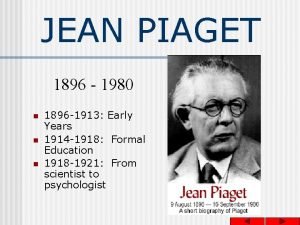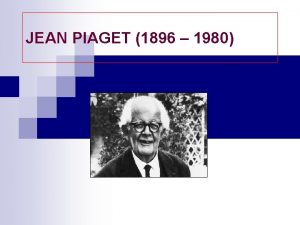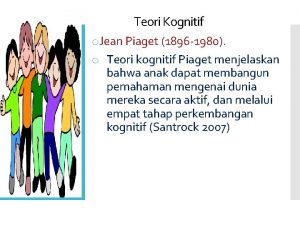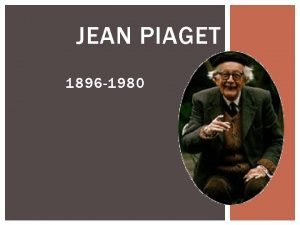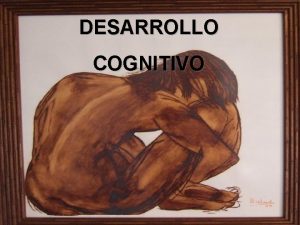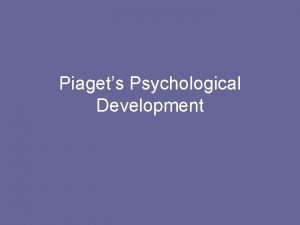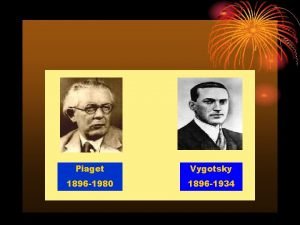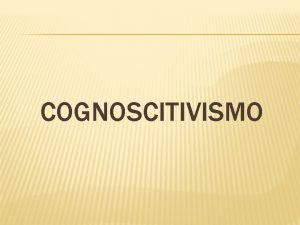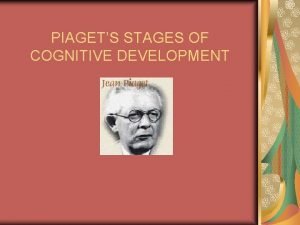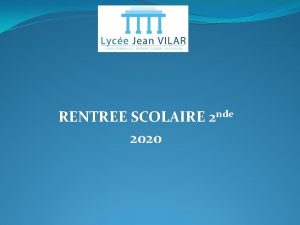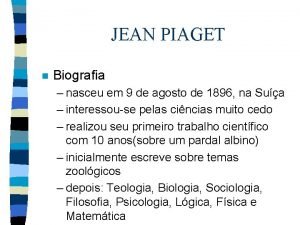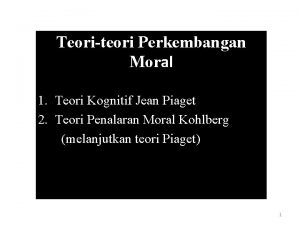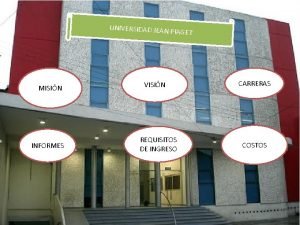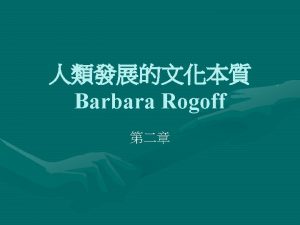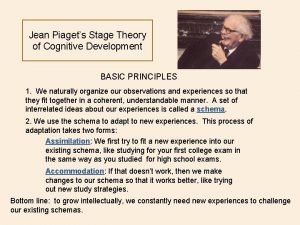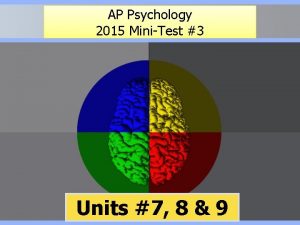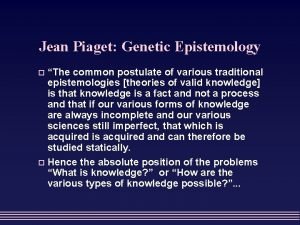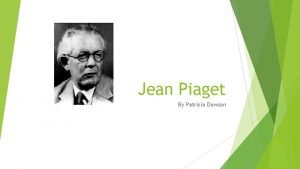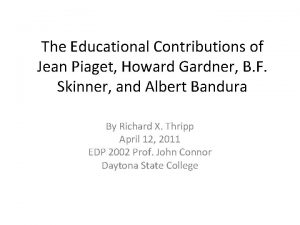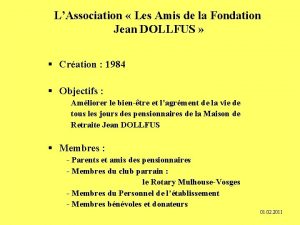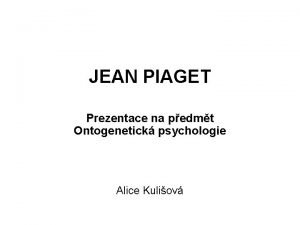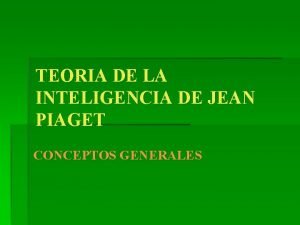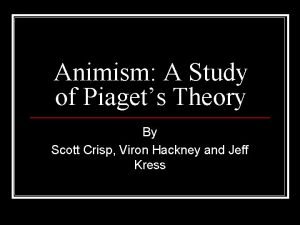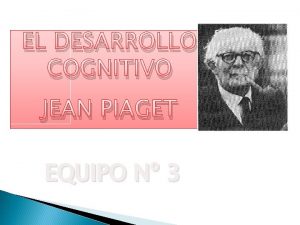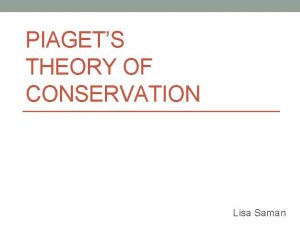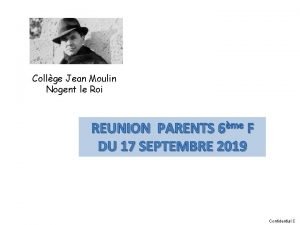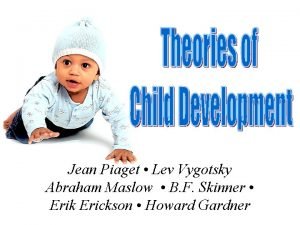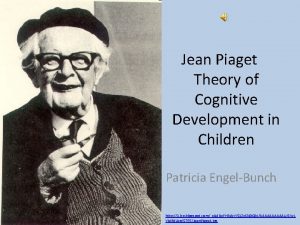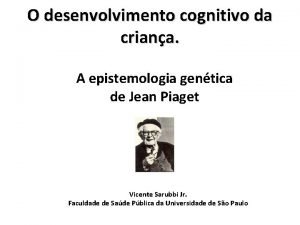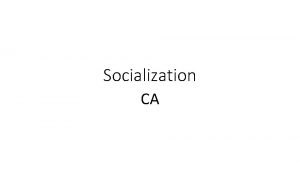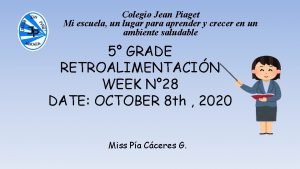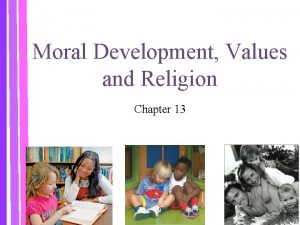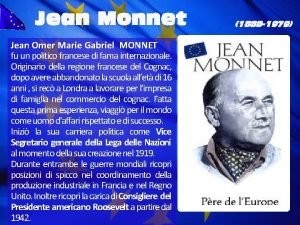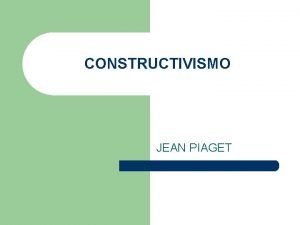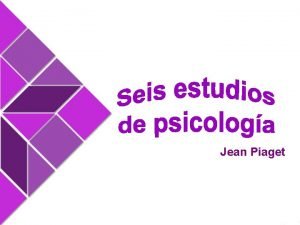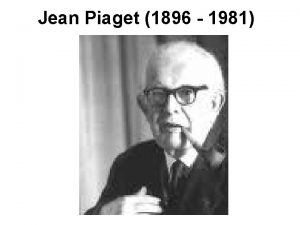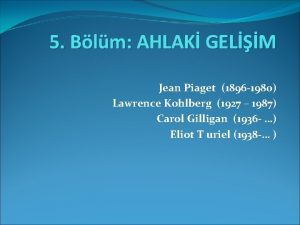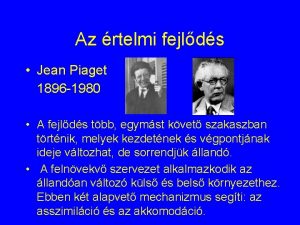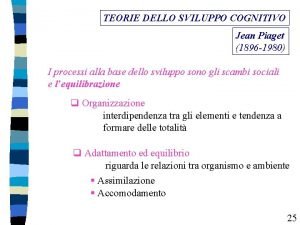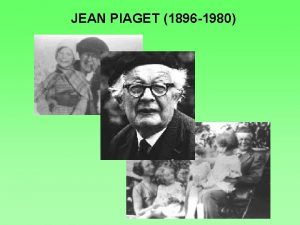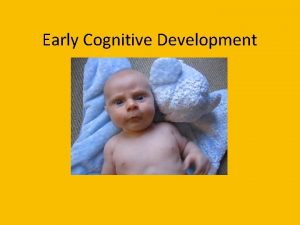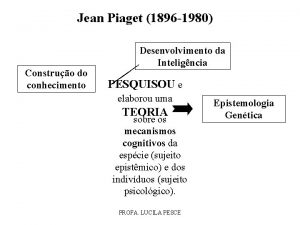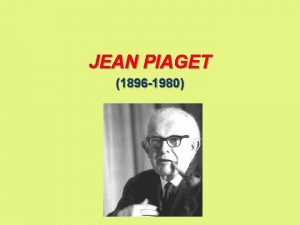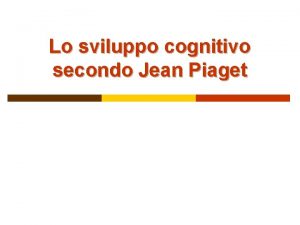JEAN PIAGET 1896 1980 n n n 1896





































![Research Studies Piaget's research methods were based primarily on case studies [they were descriptive]. Research Studies Piaget's research methods were based primarily on case studies [they were descriptive].](https://slidetodoc.com/presentation_image_h/7fce04810f6b9688fdad56db29ddfa29/image-38.jpg)





- Slides: 43

JEAN PIAGET 1896 - 1980 n n n 1896 -1913: Early Years 1914 -1918: Formal Education 1918 -1921: From scientist to psychologist

PIAGET A Brief Biography* • Born in Switzerland in 1896 • Research on sparrow and mollusks • Earned a doctorate in the natural sciences • Began to study children in 1920 • Became very interested in “wrong” answers • Continued his studies on his own children • Died in 1980 * Information from http: //www. piaget. org/ and Crain, William. “Piaget’s Cognitive-Developmental Theory. ”

The Study of Children’s Thinking n n Age 10(1906): published article on albino sparrow Age 21: Ph. D in natural sciences 1918 -1921: From science to psychology 1921 -1929: Jean-Jacques Rousseau Institute n n n 1925 Jacqueline 1927 Lucienne 1931 Laurent 1929 -1939: Research resulted in Stage Theory 1940 -1980: Research and Extension

Piaget’s Cognitive-Development Theory n n Piaget conceived of human cognition as a network of psychological structures created by an active organism constantly striving to make sense of experience. Piaget received his early training in biology and philosophy and this influence is evident in his theory. n According to Piaget, just as the body has physical structures that enable it to adapt to the environment, so the mind builds psychological structures that permit it to adapt to the external world.

Basic Terminology n n Organization Scheme n Adaptation n Assimilation Accommodation Equilibrium

Organization Piaget believed that human beings inherited the tendency to organize

Scheme n n n Cognitive or mental structures by which an individual intellectually adapts to and organizes the environment Repeated patterns of behavior that develop by trial and error Never stop changing; constantly refined

Organization n Schemes also change through a second process called organization. It takes place internally, apart from direct contact with the environment. Once children form new structures, they start to rearrange them, linking them with other schemes to create a strongly interconnected cognitive system.

Adaptation n n Adaptation involves building schemes, or psychological structures, through direct interaction with the environment. According to Piaget, adaptation consists of two complementary activities: n n n Assimilation – using current schemes to interpret the external world. Accommodation – adjusting old schemes or creating new ones after noticing that current thinking does not capture the environment completely. Piaget used the term disequalibration to describe the implementation of assimilation and accommodation to create equilibrium between thinking and reality.

Assimilation n Cognitive process by which a person integrates new perceptual matter or stimulus events into existing schemes Part of the adaptation process by which individual cognitively adapts to and organizes the environment Ongoing process

Accommodation n n Creation of new schemes or modification of old schemes Reflects a failure of assimilation Accommodation occurs, then assimilation tried again Assimilation is always the end-product

Equilibration/ Equilibrium n Balance between assimilation and accommodation n The person faced with understanding a new type of woman has to deal with situations that can not be fully handled by existing schemes. This, in Piaget's theory, creates a state of disequilibrium, or an imbalance between what is understood and what is encountered. People naturally try to reduce such imbalances by using the stimuli that cause the disequilibrium and developing new schemes or adapting old ones until equilibrium is restored. This process of restoring balance is called equilibration. According to Piaget, learning depends on this process. When equilibrium is upset, children have the opportunity to grow and develop.

Equilibration/ Equilibrium n Teachers can take advantage of equilibration by creating situations that cause disequilibrium and therefore pique students interest/curiosity/discomfort. To resolve any disequilibrium, students must accommodate a new perspective and grow in understanding. However, not all students can detect the discrepancies in new words, images, or ideas that might create disequilibrium. This is a skill that improves as a person's cognitive abilities develop.

Stages of Development n Piaget believed that children move through four stages of development. n n n Sensorimotor, Preoperational, Concrete Operational, Formal Operational. Through these stages exploratory behaviors of infants are transformed into the abstract, logical intelligence of adolescence and adulthood. Piaget’s stage sequence has two important characteristics: n n It is invariant – stages always follow a fixed order. It is universal – stages are assumed to describe the cognitive development of children everywhere.

Stages of Cognitive Development Sensorimotor n Pre-operational n Concrete operational n Formal operational n

The Sensorimotor Stage n n According to Piaget, at birth infants know so little that they cannot purposefully explore their surroundings. Circular reactions provide newborns with a special means of adapting their first schemes. n n n It involves stumbling onto a new experience caused by the baby’s motor activity. The reaction is circular because the infant tries to repeat the event again and again. As a result, the accidental response becomes strengthened into a new scheme.

Sensorimotor n n n Stage one: random and reflex actions (birth – 1 month) Stage two: primary circular reactions (1 – 4 months) Stage three: secondary circular reactions (4 -8 months) n n n Stage four: Coordination of secondary schemata (8 -12 months) Stage Five: Tertiary circular reactions (1218 months) Stage six: Mental combinations (18 months – 2 years)

Sensorimotor Substages n n n Substage 1 – Reflexive Schemes (birth to 1 month) – reflexes are the building blocks of sensorimotor intelligence. Substage 2 – Primary Circular Reactions (1 to 4 months) – gain voluntary control over actions by repeating chance behaviors. Substage 3 – Secondary Circular Reactions (4 to 8 months) – repeat interesting effects in the external world that are caused by baby’s own actions.

Sensorimotor Substages, Continued n n n Substage 4 – Coordination of Secondary Circular Reactions (8 to 12 months) – secondary circular reactions are combined into new, more complex action sequences. Substage 5 – Tertiary Circular Reactions (12 to 18 months) – circular reactions become experimental and creative. Substage 6 – Mental Representation (18 to 24 months) – the ability to create mental representations of reality.

From Sensorimotor to Pre-Operational: Object Permanence develops in this phase. The first development takes place in stage 3, at 410 months. In stage 4 (10 - 12 months) object permanence becomes more prominent in children’s play. Infants have a completely developed sense of object permanence before entering Preoperational thought.

Object Permanence Until stage 3, infants have no sense of objects outside of themselves. As they mature, their egocentrism fades, and they begin to recognize that the world exists outside of their own perception of it. A happy 8 month old baby, playing with her ball. . . until, the ball rolls out of her sight. . . and to her it is completely gone!

Pre. Operational Stage n n “Age of curiosity” Physical actions become internalized mental representations

The Preoperational Stage n n n As children move from the sensorimotor to the preoperational stage, the most obvious change is an extraordinary increase in representational, or symbolic, activity. Piaget believed that language is our most flexible means of mental representation. n By detaching thought from action, it permits cognition to be more efficient than it was during the sensorimotor stage. Piaget also believed that make-believe play was another excellent example of the development of representation during the preoperational stage. n Through pretending, children practice and strengthen newly acquired representational schemes.

Limitations of Preoperational Thought n n n Aside from the development of representations, Piaget described preschool children primarily in terms of what they cannot, rather than can, understand. According to Piaget, young children are not capable of operational thought – mental representations of actions that obey logical rules. Instead, their thinking is rigid and limited to one aspect of a situation at a time, and strongly influenced by the way things appear at the moment.

Limitations of Preoperational Thought, Continued n n n n Egocentrism – the inability to distinguish the symbolic viewpoints of others from one’s own. Animism – the belief that inanimate objects have lifelike qualities, such as thoughts, wishes, feelings, and intentions. Centration – the tendency to focus on one aspect of a situation to the neglect of other important features. Perception Bound – being easily distracted by concrete, perceptual appearances of objects. States rather than Transformations – the tendency to treat the initial and final stages in a problem as completely unrelated. Irreversibility – the inability to mentally reverse a series of steps. Transductive Reasoning – reasoning from particular to particular.

Egocentrism Child has a naïve assumption that there is only one point of view n Inability to imagine another’s perspective n Sharing example n

Perceptual Centration Child focuses on a single dimension of a problem – for instance the height of a container, but not the width n Ask for examples from class with children n Read Amelia Bedelia n

Irreversibility Child has the inability to reverse a sequence of events, such as retracing one’s steps n Library example n

Concrete Operational Stage n Piaget viewed the concrete operational stage as a major turning point in cognitive development. n n n During this stage thought more closely resembles that of adults than that of the sensorimotor or preoperational child. Concrete operational reasoning is far more logical, flexible, and organized than thinking during the preschool period. But concreter operational thinking suffers from one important limitation: n Children think in an organized, logical fashion only when dealing with concrete information they can directly perceive.

Concrete Operational Stage This stage is characterized by seven types of conservation: number, length, liquid, mass, weight, area, and volume.

Conservation Tasks

Operational Thought n Conservation – the ability to pass conservation tasks provides clear evidence of operations. n n n Children coordinate several aspects of a task rather than centering on only one, as preschoolers do. Children also have the capacity to imagine the reverse of a procedure as proof of conservation. Seriation – the ability to order items along a quantitative dimension. n Children, provided with an ordering task, create a series efficiently by beginning with the smallest item, then moving to the next smallest, and so on, until the ordering is complete.

Concrete Operational Stage • Intelligence is demonstrated through logical and systematic manipulation of symbols related to concrete objects. • Operational thinking develops (mental actions that are reversible). • Egocentric thought diminishes.

Formal Operational Stage n n n According to Piaget, the capacity for abstract thinking begins with the formal operational stage. Adolescents reason much like a scientist searching for solutions in the laboratory. Concrete operational children can only operate on reality, formal operational adolescents can operate on operations. Concrete things and events are no longer required as objects of thought. Adolescents can come up with new, more general logical rules through internal reflection.

Formal Operational Stage • Intelligence is demonstrated through the logical manipulation of symbols related to abstract concepts. • Early in this period there is a return to egocentric thought. • Many adults never attain this stage.

Reasoning Ability n Hypothetico-Deductive Reasoning – a formal operational problem-solving strategy in which adolescents begin with a general theory of all possible factors that could affect an outcome in a problem and deduce specific hypotheses, which they test in an orderly fashion. n Propositional Thought – a type of formal operational reasoning in which adolescents evaluate the logic of verbal statements without referencing to real-world circumstances.

Consequences of Abstract Thought n n Adolescents’ capacity to think abstractly, combined with the physical changes they are undergoing, means that they start to think more about themselves. Piaget believed that they arrival of formal operations is accompanied by a new form of egocentrism: the inability to distinguish the abstract perspective of self from other. n n Imaginary Audience – adolescents’ belief that they are the focus of everyone else’s attention and concern. Personal Fable – adolescents’ belief that others cannot possibly understand their thoughts and feelings.
![Research Studies Piagets research methods were based primarily on case studies they were descriptive Research Studies Piaget's research methods were based primarily on case studies [they were descriptive].](https://slidetodoc.com/presentation_image_h/7fce04810f6b9688fdad56db29ddfa29/image-38.jpg)
Research Studies Piaget's research methods were based primarily on case studies [they were descriptive]. While some of his ideas have been supported through more correlational and experimental methodologies, others have not.

Research Studies For example, Piaget believed that biological development drives the movement from one cognitive stage to the next. Data from cross-sectional studies of children in a variety of western cultures seem to support this assertion for the stages of sensorimotor, preoperational, and concrete operations.

Research Studies

Research Studies However, data from similar cross-sectional studies of adolescents do not support the assertion that all individuals will automatically move to the next cognitive stage as they biologically mature. For formal operations, it appears that maturation establishes the basis, but a distinct environment is required for most adolescents and adults to attain this stage.

Research Studies

Research Studies Although research does not support all of Piaget’s descriptive theory, it is still influential for parent’s and educators.
 Jean piaget 1896 a 1980
Jean piaget 1896 a 1980 1980-1896
1980-1896 Jean piaget 1896-1980
Jean piaget 1896-1980 Jean piaget (1896-1980)
Jean piaget (1896-1980) 1980-1896
1980-1896 Jean piaget background
Jean piaget background Periodo preoperacional piaget
Periodo preoperacional piaget 1980-1896
1980-1896 1980-1896
1980-1896 1980-1896
1980-1896 Ginebra 1980
Ginebra 1980 Jean piaget preoperational stage
Jean piaget preoperational stage Lycée robert de mortain pronote
Lycée robert de mortain pronote Application of piaget theory
Application of piaget theory Biografia de piaget
Biografia de piaget Tahap heteronomous
Tahap heteronomous Iaget
Iaget Jean piaget steckbrief
Jean piaget steckbrief Jean piaget zone of proximal development
Jean piaget zone of proximal development Jean piaget preoperational stage
Jean piaget preoperational stage Contexto inmediato
Contexto inmediato According to jean piaget children cease to exhibit
According to jean piaget children cease to exhibit Jean piaget genetic epistemology
Jean piaget genetic epistemology Jean piaget bio
Jean piaget bio Jean piaget wikipedia
Jean piaget wikipedia Jean piaget and howard gardner
Jean piaget and howard gardner Fondation jean piaget
Fondation jean piaget Jean piaget referat
Jean piaget referat Piaget's theory of cognitive development
Piaget's theory of cognitive development Filosofia de vida
Filosofia de vida Animism piaget stage
Animism piaget stage Estructuras piaget
Estructuras piaget Jean piaget graphic organizer
Jean piaget graphic organizer Istituto jean piaget
Istituto jean piaget Piaget's water conservation task age
Piaget's water conservation task age Ent jean moulin albertville
Ent jean moulin albertville Jean piaget lev vygotsky
Jean piaget lev vygotsky Jean piaget daughter
Jean piaget daughter Jean piaget estágios de desenvolvimento
Jean piaget estágios de desenvolvimento Types of socialization
Types of socialization Escuela jean piaget
Escuela jean piaget Jean piaget video
Jean piaget video Jean piaget theory of moral development
Jean piaget theory of moral development Jean monnet jean-gabriel monnet
Jean monnet jean-gabriel monnet

